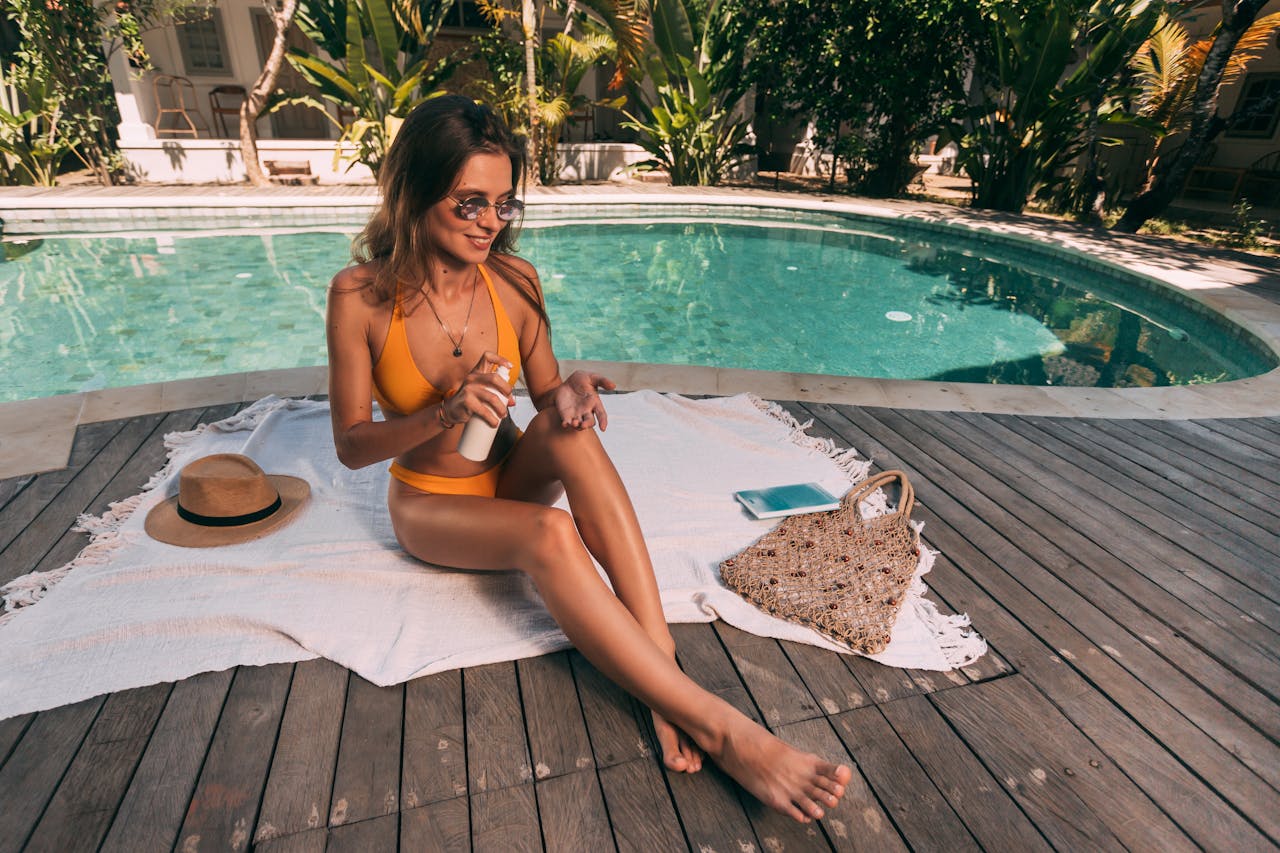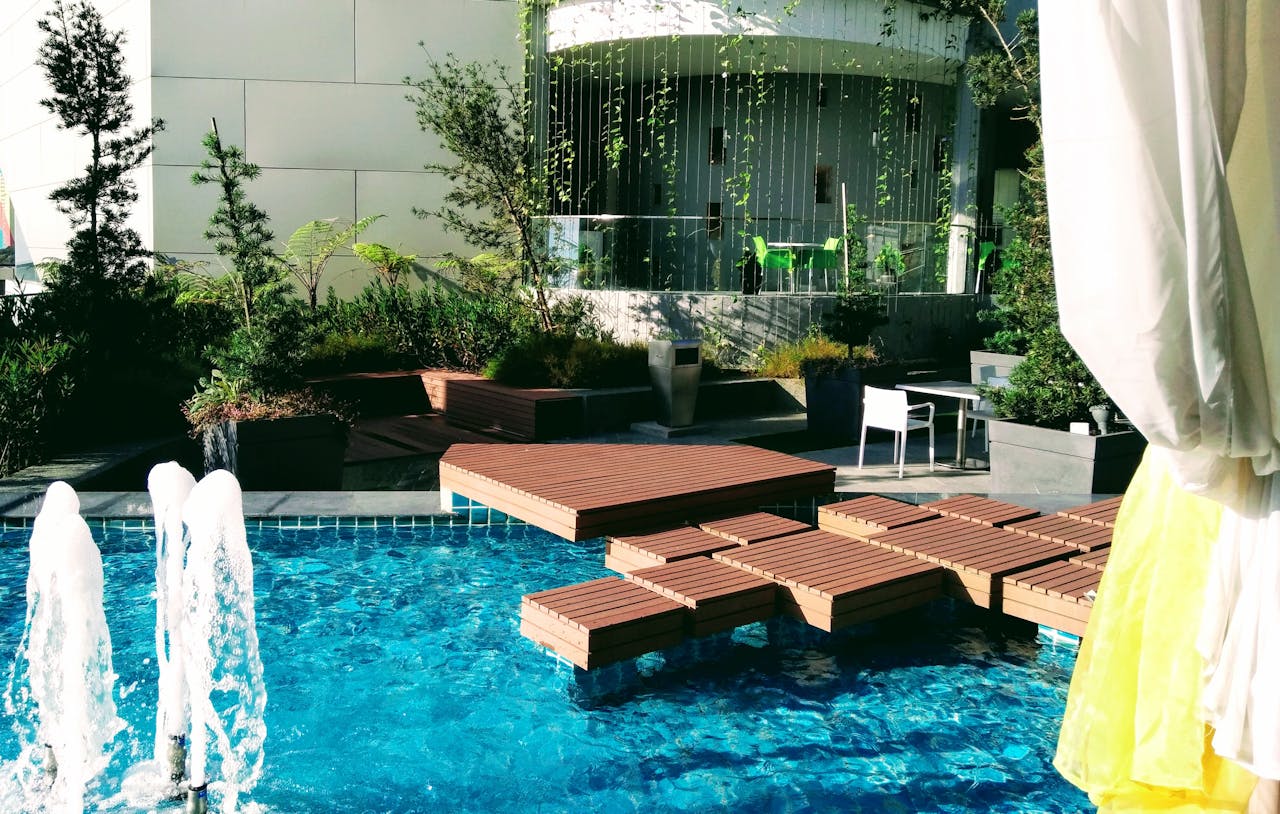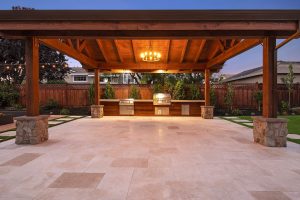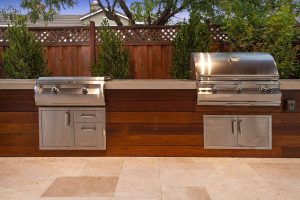A lot of pool owners opt for concrete pavers, natural stone, and porcelain tiles for their combination of safety and aesthetics. Concrete pavers offer a straightforward, clean look and are available in numerous shapes and colors. Natural stone, like travertine or limestone, provides a durable surface and complements pool water and surrounding foliage. Porcelain tiles, with their dense construction, resist water and are simple to wipe clean. To choose the ideal paver style, most people consider factors like maintenance, traction, and performance in wet areas. The body then tears into these choices and assists in selecting the best fit for pool decks.
Key Takeaways
- Slip resistance, heat reflection, and chemical endurance should be priorities for pool pavers for safety, comfort, and long-term durability in any climate. From a practical standpoint, opt for materials that provide textured finishes, reflect sunlight, and resist pool chemicals to limit upkeep and improve the overall experience.
- From travertine to concrete, porcelain to natural stone, and even brick, there are plenty of options to choose from when it comes to your poolside pavers.
- Combine pool pavers with landscaping and smart designs to create an elevated aesthetic and functional appeal to your pool area. Designate functional spaces, apply color psychology, and mix textures and scales to craft a balanced and welcoming outdoor space.
- Proper base prep, drainage planning, and joint stabilization can have a huge impact on the structural integrity and longevity of your pool paver installation. If you buy some quality base layer materials and periodically check the drainage systems, you shouldn’t run into any water-related issues.
- By implementing a detailed maintenance schedule consisting of regular cleaning, stain control, seasonal care, and prompt repairs, you’ll safeguard your investment and enjoy enduring beauty and functionality. Clean them with the right products and fix damage quickly to prevent expensive repairs.
- Use these suggestions to design a poolside oasis that is secure, beautiful, and durable–no matter your location or climate. A little research before you buy will make your pool area more enjoyable and long-lasting for everyone who appreciates it.
Essential Qualities For Pool Pavers
Pool pavers have to be extremely safe, comfortable, and durable. How they hold up in wet-hot and chemical harshness separates the great choices from the others. The following table summarizes the core qualities and considerations for selecting pool pavers:
Key Quality | Importance | Considerations |
Slip Resistance | Prevents falls and injuries | Texture, finish, material, and wet environment suitability |
Heat Reflection | Keeps surfaces cool for bare feet | Color, material, shade, surface temperature |
Chemical Endurance | Maintains appearance and structure over time | Stain resistance, porosity, saltwater compatibility |
Durability | Withstands traffic, furniture, and weather | Impact resistance, climate, warranty, and repairability |
Heat Reflection
Lighter-colored pavers, such as limestone or pale sandstone, reflect sunlight and remain cooler in summer. This characteristic becomes so important in warm climates where bare feet are abundant. Others, like concrete with reflective pigments, go one step further to reduce heat buildup. Testing surface temps at mid-day reveals which option keeps comfort tops.
Landscaping can assist. Trees and pergolas provide shade that reduces heat on the deck, as well as visual interest.
Chemical Endurance
Chlorine, salt, and other pool chemicals can stain or erode inferior pavers. Dense, low-porosity materials—such as porcelain or sealed concrete—resist chemical absorption and staining. Saltwater pools require pavers that can endure salt’s corrosive properties. Always check with manufacturers that their products are a match for chemical exposure, and check warranties for additional peace of mind.
Overall Durability
Impact-resistant materials such as granite or concrete withstand wear and tear from heavy foot traffic, shifting furniture, and freeze-thaw cycles. A deep, stable gravel base – 6–8 inches of compacted “crusher run” – keeps everything from shifting and cracking, particularly in areas with severe winters. Low-maintenance repairs are another advantage: if a paver cracks, it can be swapped out without disturbing the whole deck.
Designing Your Poolside Oasis
A poolside oasis marries practicality with aesthetics, dressing up the scene while keeping the area safe. Choosing pavers that complement your landscape, pool shape, and home style is crucial. Consistency — in materials, colors, and scale — ties the whole space together, while touches like Mediterranean-style decks with earthy terracotta or copper tones conjure up a warm, leisure-focused vibe. Decorative borders or accents provide detail and polish the pool area to feel complete.
Aesthetics do more than make a place look nice; they direct the flow of use. Porcelain pavers provide a resilient, weatherproof quality for a more sophisticated aesthetic, whereas wood adds a gentle, organic texture to your design; however, it requires maintenance to avoid slipperiness. Mixing paver colors and sizes, you can create uniquely designed areas that stand out from the crowd and express your personality.
- Define dining, lounging, and sunbathing spots using paver zones.
- Design walkways to link the pool with the house and garden.
- Add shaded retreat spaces, maybe with pergolas or trees.
- Contain water and define borders with raised edges.
Adornments such as patterned inlays or accent stones help to both break up expanses and set the tone. Bringing in natural elements—plants, rocks, water features—continues to blend the pool with its environment, promoting tranquility and a connection to nature.
Color Psychology
Light blues and soft greys help set a relaxed tone, while these earthy tones—terracotta, copper, rust—warm up the space, channeling a Mediterranean vibe. Contrasting colors — like these pale pavers with dark borders — add depth and focus. Color affects comfort: darker shades absorb more heat, making them less ideal in hot climates, while lighter colors stay cool. Bright hues can be a brassy, whimsical declaration — but require thoughtful coordination so they don’t rub against the rest of the backdrop.
Texture And Finish
Textured pavers, such as tumbled or brushed varieties, increase slip resistance and safety, a key concern poolside. Polished finishes provide a sleek, contemporary shine but tend to be slippery when wet. Juxtaposing rough with smooth surfaces is visually and physically engaging. Texture is important for maintenance: while rougher pavers can collect debris, they camouflage wear better than smoother ones.
Paver Scale
Large-format pavers provide a seamless, modern vibe and complement larger spaces. Little pavers come in handy for fancy edging or a tricky mosaic–adding timeless appeal. Mixing scales – big slabs for main paths, small pavers for accents – keeps things interesting and prevents it from feeling too cookie-cutter. In harmony with nearby elements like gardens or fences.
Pattern Language
Design Your Poolside Oasis: Patterns transform the ambiance and use of pool decks. Herringbone or basketweave patterns are classic; they provide timeless appeal along with enhanced traction. Geometric layouts, such as linear or modular grids, have a modern, tidy feel. Mixing in patterns or adding decorative bands can divide areas or accentuate elements. Smart design makes sure that water runs off away from the pool, minimizing puddles and preventing accidents.
The Unseen Foundation
A poolside patio requires more than attractive surface pavers; its dependability is beneath. The unseen foundation is the true hero of any paver installation. Without such pavers as a foundation, beautiful pavers can shift, crack, and eventually fail. Drainage, soi, and jointing methods all contribute to making a safe, durable zone around pools.
Base Preparation
The initial phase is site clearance—removing grass, roots, or loose soil guarantees that nothing will impede the foundation. Soil compaction is mandatory – it creates the foundation of a solid base, particularly in high clay areas. If the base isn’t compacted, you’ll experience uneven settling, which can result in cracked or shifted pavers down the road. Leveling comes next, and is really important to be completely flat; a slight slope, approximately 6 mm per 300 mm, ensures water will drain away from the pool. In areas with dense clay soil, placing a geotextile fabric between the soil and base helps stop soil movement and weed intrusion, both of which can wreak havoc on your paver system.
Proper Drainage
Just make sure you plan for drainage! The grade sloped to draw water off the pool edge—a typical measure is 6 mm per 300 mm. Add drainage swales or tile drains if your soil retains water. Permeable pavers allow water to seep through, minimizing runoff. Local weather patterns matter: heavy rain demands more robust drainage. Routine checks of all drainage components can identify blockages or malfunctions early, saving the entire system.
Jointing Sand
Jointing sand holds pavers together and blocks weeds. Polymeric sand (a hardening sand used when wet) is frequently the ideal option for pool surrounds. It holds up to foot traffic and won’t wash out. Applying the sand correctly is key: sweep it into the joints, then mist with water for curing. Over time, the joints will lose sand from cleaning or weather, so they will need to be refilled periodically. Be aware, though, that not all sand is equal–some harmonize better with certain paver types, so heed manufacturer recommendations before purchase.
Sealing Options
It helps protect pavers from stains, fading, and weather when sealed. A lot of sealers enhance color and UV protection, keeping it looking fresh. The application is typically cleaning, drying, and then applying the sealer evenly. Timing is everything–plan when dry weather is predicted. To maintain protection and appearance, resealing every few years is advised.

Future-Proofing Your Investment
Paver styles around pools provide a great combination of durability, elegance, and investment value, but their benefits are contingent upon proper care and maintenance. If done right, quality pavers will look great and hold up for more than 50 years, blowing away the life expectancy of traditional concrete. Here’s how to future-proof your investment.
Routine Cleaning
- Sweep pavers weekly to clear sand, leaves, and debris.
- Rinse with water and a gentle soap for your paver variety.
- Spruce it up with a pressure washer when you need deep cleaning, but don’t turn up high if you don’t want to erode joints.
- Check for mold or algae following heavy rain and treat with a diluted vinegar solution or approved antifungal.
Routine cleaning not only preserves the appearance of pavers but also reduces the risk of abrasion. Pick mild, paver-safe cleaners that won’t dull the material or damage the finish. A deep clean with a pressure washer will bring back the color, but it washes out the sand in the joints, so it’s best to use them sparingly. Algae/Moss Algae or moss can cause long-term damage and compromised safety.
Stain Management
Don’t wait to address spills. They are stains from food or drink or leaves, and they can set fast in porous materials. For future-proofing your investment, always use cleaners designed for your particular type of paver. Test new products on a hidden spot first for color fade or surface change.
Create a user checklist with these common staining substances: wine, coffee, sunscreen, plant materials, pool chemicals, oils, and rust from metal furniture. Share this with users to avoid reckless spills!
Seasonal Care
Protect pavers from ice in colder climates with rubber mats or sand, but never salt, which can erode surfaces. Remove debris and leaves frequently – particularly in the fall – to prevent rot and staining.
Change maintenance habits with the seasons—check more often during rainy months, and after storms, inspect carefully for cracks or shifting. Survey it after harsh weather for warning damage that — if caught early — is easier to repair.
Repair Strategy
Have a strategy for chips and cracks. Save extra pavers from your initial batch for fast swaps. If damage impacts multiple tiles or the base underneath, reach out to a professional to evaluate and repair.
By refilling sand and sealing the joints, you’re helping to future-proof your investment. Sure, it’s cheap to replace a couple of pavers, but it can get expensive if you don’t take care of it.
Conclusion
Pool pavers are available in a multitude of styles, and each has its own strengths in terms of appearance, traction, and durability. Concrete pavers lend a sharp, crisp appearance, while stone adds coziness and appeal. Porcelain, however, stays cool and makes maintenance easy. The right pavers help prevent slips, reduce heat, and resist water and sun. Lay a solid foundation and select a style that suits your palette and your climate. The right paver lasts for years and keeps your pool secure. Looking to discover the perfect match for your area? Browse real-world stories from other pool owners or consult a local-area pro. Got your own tips or questions? Any pool can be stunning and safe with the perfect selection.
Frequently Asked Questions
1. What Are The Most Slip-Resistant Paver Materials For Pool Areas?
Textured concrete, natural stone, and porcelain pavers are extremely slip-resistant. They offer a more grippy surface, which helps avoid slips and falls around pools.
2. Which Paver Colors Stay Coolest Under The Sun?
Colors such as beige, light gray, and cream reflect sunlight and keep surfaces cooler. These colors are perfect for hot climates and add to the comfort of bare feet.
3. Are Porcelain Pavers Suitable For Pool Decks?
Porcelain pavers, for example, are durable, water-resistant, and come in a variety of styles. They resist fading and stains, which can make them a practical and contemporary pick for pools.
4. How Do I Choose A Paver Style That Matches My Pool Design?
As far as paver styles, pick what works for your pool’s shape and your outdoor theme. Large-format pavers complement sleek, modern pools, and tumbled stone or mosaics pair nicely with traditional designs.
5. What Makes A Good Foundation For Pool Pavers?
Underneath, a solid base utilizes compacted gravel and sand. This base provides drainage, stability, and durability for your pool paver installation.
6. How Can I Future-Proof My Poolside Paver Investment?
Choose sturdy, weatherproof substances and classic designs. Routine upkeep and sealing further preserve the longevity and aesthetics of your pool pavers.
7. Do I Need Professional Installation For Pool Pavers?
We do recommend professional installation fothe r best results! Experts guarantee drainage, safety surfaces, and durability, safeguarding your investment.
Transform Your Backyard with DPG Design & Build’s Expert Pool Deck Pavers!
Imagine stepping onto a beautiful pool deck designed just for you, featuring durable pavers, elegant patterns, slip-resistant surfaces, and a layout that makes every swim or gathering feel like a luxury experience. At DPG Design & Build, we specialize in pool deck paver installations that combine style with functionality, turning your outdoor space into a stunning retreat. With over 30 years of expertise serving Danville and Walnut Creek, California, we’ve built a reputation as the go-to experts in outdoor living design.
Our team, featured on HGTV’s Curb Appeal and the Discovery Channel’s Renovation Nation, knows how to design and install pool deck pavers that enhance both your lifestyle and your home’s value. Using state-of-the-art 2-D and 3-D design technology, we’ll show you your new deck before installation begins, ensuring every detail matches your vision.
At DPG Design & Build, we don’t just install pavers; we create spaces that elevate the way you enjoy your backyard. From choosing the best materials and colors to selecting patterns and finishes, our personalized approach ensures your pool deck looks incredible and lasts for years. Whether you’re building a new pool deck or upgrading an old one, our team is here to guide you every step of the way.
Book your complimentary consultation today, and let’s create the perfect pool deck with pavers designed for beauty, durability, and comfort!
Disclaimer: This article is for informational purposes only and does not constitute professional advice. Always consult with a licensed and insured paving contractor before starting any driveway project. Requirements may vary depending on local regulations and site conditions.






